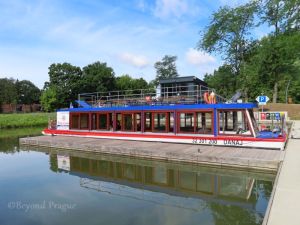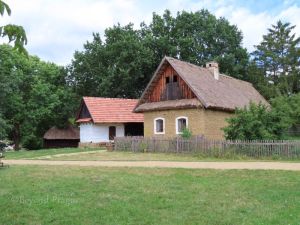A View from the Water
The Slovácko region, in the extreme south-east of the the Czech Republic is notable as part of the Moravian wine growing regions as well as idylic vistas of farmland and hills.
The region is also notable for a strong Slovak influence on its folklore and traditions, it has some of the most distinctive folk costumes among Czech regions.
There are many ways to experience Slovácko. One of the more unique ways is by taking a cruise on the Baťa canal.
The Baťa canal runs along the Morava river for about 52 kilometres between Otrokovice, near Zlín, to a southern terminus at Rohatec.
Along the course of the canal, there are 13 locks and more than 20 bridges. There are nine ports along the canal with visitor information and services.
Let’s spend some time on the Baťa canal:
A Historic Voyage
A cruise on the Baťa canal will not only put you in touch with the Slovácko region and its offerings, it will also put you in touch with a unique part of Czech history in the canal itself.
The canal was built between 1934 and 1938. However, it was intended as the starting point of a much bigger idea that dates back to the 14th century.
Charles IV (1316-1378), Holy Roman Emperor and king of Bohemia, envisioned a canal that would connect the Oder river to the Danube. It was an idea that would be revived a number of times through history. The idea of such a canal still survives to the present, in spite of going so long unrealized.
Tomáš Baťa (1876-1932), founder of the famous Bata shoe company, was a strong proponent of connecting the Oder and Danube when the idea was revived in the late 19th and early 20th centuries.
Baťa saw a need to regulate the flow of the Morava river so water from it could be better used to irrigate the farm land surrounding it. Additionally, he saw the construction of a canal as a way to move coal that was mined near Rohatec to the power generating station in Otrokovice that provided power to his factories there and in Zlín.
In the bigger picture, his planned canal was seen as the first step in connecting the Oder and Danube.

What would become the Baťa canal was partly financed by Baťa and partly by the Czechoslovak state. Jan Antonín Baťa, the half brother of Tomáš, took over the family business interests after Tomáš died and continued to support the construction of the canal.
The Baťa canal was completed in autumn of 1938. Shortly after, in spring of 1939, German forces occupied Czechoslovakia. During the Second World War, the canal was used to keep coal and other supplies running in the region. However, at the end of the war, retreating German forces inflicted heavy damage on the canal.
While repair work to the canal lasted until the end of the 1940s, its importance for transportation diminished and it fell into complete disuse by the early 1970s.
Little interest in reviving the Baťa canal was shown until the fall of Socialism in 1989. It was at that time that the idea of a canal connecting the Oder to the Danube saw another revival.
Through the early 1990s, repairs were carried out on the Baťa canal and it was opened to sightseeing cruises in 1995.
Today, the canal is one of the most popular tourist attractions in the Slovácko region.
Experiencing the Baťa Canal
There are many different ways to connect with the Baťa canal and surrounding area.
Aside of the aforementioned boat cruises, a significant part of the canal has cycling paths running alongside it that are connected to other paths in the area. As such, it’s not difficult to experience the region on two wheels if that’s your preference.
There are some companies that even offer sightseeing flights over Slovácko that would allow you to see the canal and surroundings from above if you’d like.
For this article, I’ll cover a sightseeing cruise that we took in early July of 2023.
Our cruise lasted for about two hours and took us from Veselí nad Moravou to Strážnice on the boat Danaj.
It was an enjoyable and relaxing ride that took us past a great deal of the idylic agricultural land that Slovácko is famous for.
Along the way, we shared the canal with smaller rental boats as well as houseboats. Very often there was quite a bit of interaction and photo taking between people on the boats and cyclists alongside the canal.
Staff on our boat gave some commentary in Czech on the history of the canal and some of what we were seeing along the way.
On our cruise, we were warned to keep our heads down while going under bridges as heavy rains in the previous days had caused the canal’s water level to rise. On every bridge, there were people waving to us and watching us duck to avoid the bridge. It was a great source of amusement for the people on the bridges, and most of the people on the boat saw the humour of the situation as well.
After about two hours, we arrived at Strážnice just in time for lunch. We got off the boat, bought a couple of small souvenirs and made our way to a nearby restaurant.
After lunch, we visited Skanzen Strážnice. This is an open air historic village that represents Slovácko folk architecture and traditions.
Strážnice is one of the recommended places to go if you wish to sample local wine. The city also hosts an annual international folklore festival, so you could also take that in if you time your visit accordingly.
Taking a Cruise and Learning More
Cruise season on the Canal runs from the start of May to the end of October.
Our cruise gave us just a small taste of what can be seen and done along the Baťa canal. For more details about cruise options and how to get on a cruise, a good first stop would be the canal’s official website.
If you would like to know more about the history of the canal, the following link will take you to a historical timeline of it.
If you wish to know more about Slovácko itself, visit the region’s official website. The website is available in English, German and Polish as well as Czech.






